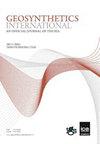从直剪试验推断残余GMX/GDC界面强度
IF 3.3
2区 工程技术
Q2 ENGINEERING, GEOLOGICAL
引用次数: 0
摘要
残余界面强度沿土工合成衬砌区(如填埋边坡)的边坡进行动员。不幸的是,在常用的直剪试验中,只测量了大位移(LD)界面强度,由于有限的连续剪切位移和试验中引入的新土工膜,其对残余界面强度的预测过高了约40%。商业实验室通常按照ASTM D5321或D6243进行直接剪切试验,只能测量LD界面强度。本文提出了一种从直剪试验结果中估计残余界面强度的方法,该方法能较好地估计现场界面强度。环剪试验的剪切应力-位移关系拟合幂函数,可将直剪试验结果推断为残余强度。本文表明,幂函数可以根据直剪试验中测得的剪切应力-位移关系预测合理的界面残余强度。该方法使人们能够在只有直剪试验结果的情况下估计残余强度数据,并防止在边坡稳定性评估中对安全系数(FoS)的过度预测。本文章由计算机程序翻译,如有差异,请以英文原文为准。
Extrapolating residual GMX/GDC interface strength from direct shear tests
The residual interface strength is mobilized along sideslopes of geosynthetic lined areas, such as landfill sideslope. Unfortunately, only a large displacement (LD) interface strength is measured in frequently used direct shear tests, which overpredicts the residual interface strength by about 40% because of limited continuous shear displacement and new geomembrane being introduced during the test. Commercial laboratories usually conduct direct shear tests in accordance with ASTM D5321 or D6243, which can only measure the LD interface strength. This paper suggests a method to estimate the residual interface strength from direct shear test results, which provides a better estimate of field interface strengths. The shear stress-displacement relationship from ring shear tests fits a power function, which can be used to extrapolate direct shear test results to a residual strength. This paper shows the power function can predict reasonable residual interface strengths from the shear stress-displacement relationship measured in direct shear tests. This method allows people to estimate the residual strength data when only direct shear test results are available and prevents overprediction of the Factor of Safety (FoS) during slope stability evaluations.
求助全文
通过发布文献求助,成功后即可免费获取论文全文。
去求助
来源期刊

Geosynthetics International
ENGINEERING, GEOLOGICAL-GEOSCIENCES, MULTIDISCIPLINARY
CiteScore
6.90
自引率
20.00%
发文量
91
审稿时长
>12 weeks
期刊介绍:
An online only, rapid publication journal, Geosynthetics International – an official journal of the International Geosynthetics Society (IGS) – publishes the best information on current geosynthetics technology in research, design innovation, new materials and construction practice.
Topics covered
The whole of geosynthetic materials (including natural fibre products) such as research, behaviour, performance analysis, testing, design, construction methods, case histories and field experience. Geosynthetics International is received by all members of the IGS as part of their membership, and is published in e-only format six times a year.
 求助内容:
求助内容: 应助结果提醒方式:
应助结果提醒方式:


